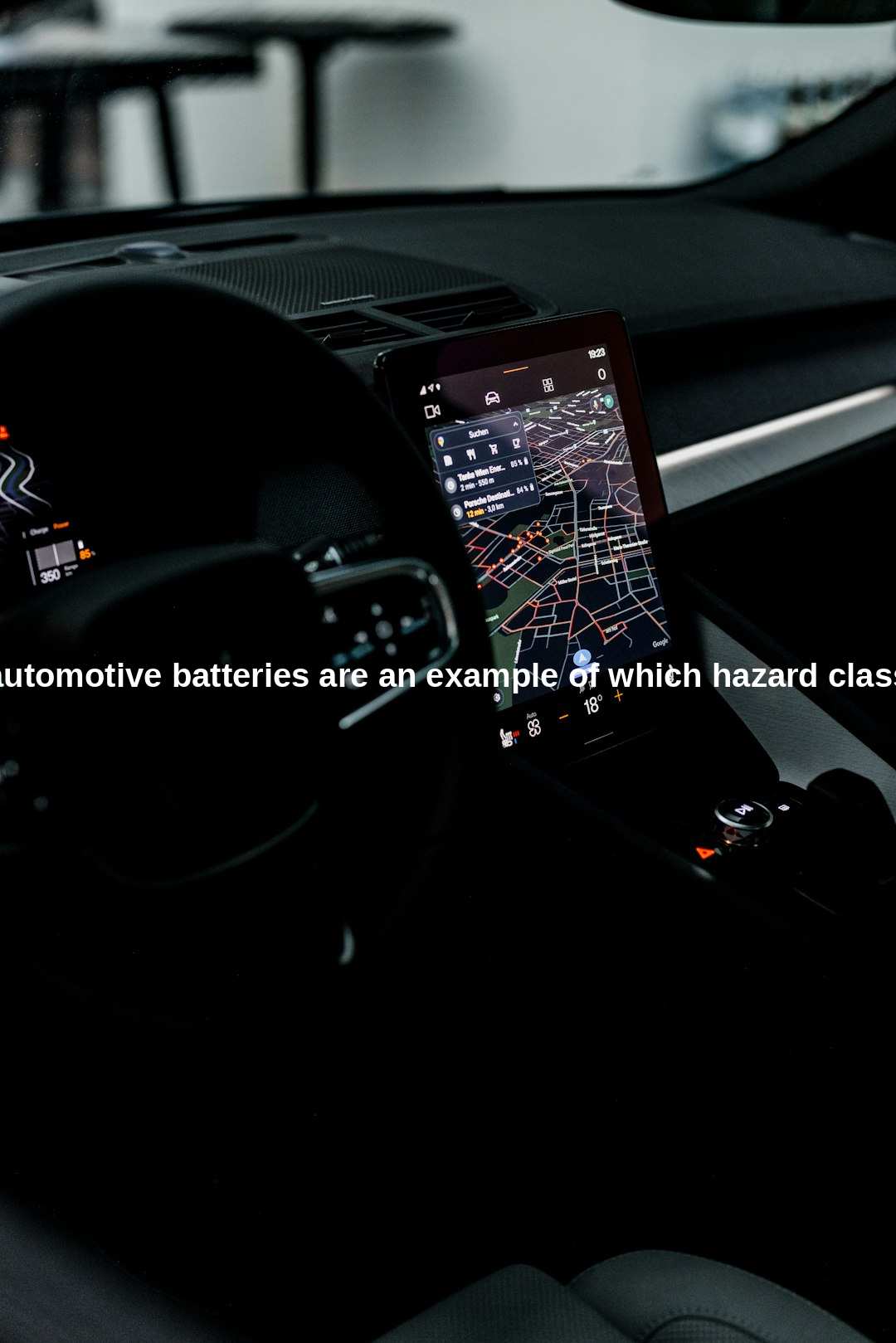Automotive batteries, essential components in vehicles of all types, are often taken for granted in terms of the energy they provide and the convenience they afford. However, the handling and disposal of these batteries raise significant safety and environmental concerns that cannot be overlooked. Knowing that automotive batteries are an example of which hazard class is crucial for anyone who manufactures, transports, or works with these batteries on a regular basis. This knowledge ensures compliance with regulations and helps mitigate risks to humans and the environment alike.
| Hazard Class | Materials | Handling Concerns | Disposal Considerations |
|---|---|---|---|
| Class 8 | Corrosive materials | Wear protective gear, prevent leakage | Follow specific regulations, avoid environmental contamination |
| — | Lead, acid | Avoid skin/eye contact and inhalation | Recycle properly, use authorized facilities |
| — | — | Proper labeling for transport | — |
| — | — | Secure batteries against movement | — |
Understanding the Risks: The Corrosive Nature of Automotive Batteries
The Chemistry of Corrosion
Automotive batteries contain sulfuric acid and lead, which together make them inherently corrosive. This characteristic poses risks not only to those who handle the batteries but also to the environment if they are not managed properly. The acid within the battery can cause severe burns to skin and eyes, and the lead is a toxic heavy metal which can contaminate soil and water. The potential for acid spills or lead leakage is what categorizes automotive batteries as a hazard class 8.
The corrosion can also affect the performance and lifespan of a battery. Over time, the lead plates within a battery can become corroded, reducing its ability to hold a charge. This not only leads to reliability issues but can also result in the untimely disposal of the battery, which has further environmental implications if not done correctly.
Handling automotive batteries requires precautions such as wearing protective clothing, goggles, and gloves, and using proper tools to prevent punctures or breaks that could lead to leaks. When transporting these batteries, they must be securely packaged and labeled accurately to ensure safety. Additionally, awareness of the potential hazards can reduce the likelihood of accidents and increase the efficiency of emergency response if an incident does occur.
Proper training for those dealing with automotive batteries, in terms of handling, storage, and emergency procedures, can significantly decrease the risks associated with their corrosive nature. Recognizing the importance of such knowledge and precautions can help maintain the safety of workers and the public while protecting our environment from unnecessary harm.
Navigating Hazardous Material Regulations: The Importance of Proper Labeling and Transportation

“Automotive batteries belong to Hazard Class 8, denoting their corrosive properties, which necessitates strict adherence to hazardous material regulations for labeling and transportation.”
Adhering to Regulations
Proper labeling and transportation of automotive batteries are governed by international and national regulations, such as those put forth by the Department of Transportation (DOT) in the United States or the ADR in Europe. These rules ensure that hazardous materials, like automotive batteries, are identified and handled in a manner that minimizes the risk of accidents during transport. Labels must clearly indicate the hazard class (Class 8 for automotive batteries), and the batteries should be securely packed in materials that resist the acids contained within them.
Transportation Compliance
When transporting automotive batteries, carriers must comply with specific safety standards to prevent the risk of spills or release of the hazardous contents. Because they are classified within Hazard Class 8, automotive batteries require meticulous methods of stabilization inside transport vehicles, and emergency protocols must be in place. Failure to comply could lead to significant environmental damage and pose health risks to humans, as well as result in legal penalties.
Safe Handling and Disposal: Protecting Yourself and the Environment
“As items under Hazard Class 8, automotive batteries demand careful handling and disposal to ensure environmental protection and personal safety.”
Personal Protective Equipment (PPE)
When handling automotive batteries, personal safety can’t be overstated. The use of personal protective equipment (PPE) is a must. This includes acid-resistant gloves, safety goggles, and even face shields and aprons, depending on the level of risk and exposure. It is essential to protect oneself from the corrosive chemicals that could cause serious bodily harm upon contact.
Environmental Stewardship in Disposal
Disposal of automotive batteries must be carried out with regard to environmental safety. Since they’re composed of lead and acid, improper disposal can contaminate soil and water, posing severe risks to wildlife and humans. Therefore, it is crucial to recycle batteries wherever possible, following governmental guidelines to minimize any potential for environmental contamination.
The Consequences of Improper Battery Connection and Disposal
“Improper battery connection and disposal not only compromises safety but also contravenes the regulations established for Hazard Class 8 materials.”
Risks of Improper Connection
Incorrect connection of automotive batteries can lead to electrical shorts, fires, and explosions. These dangers underscore the importance of ensuring that battery installation is performed by knowledgeable individuals and that proper procedures are followed to maintain vehicle safety and operational integrity.
Environmental and Legal Repercussions
The improper disposal of automotive batteries can have dire environmental consequences. Lead and sulfuric acid can leach into the ground and water systems, creating long-term health hazards. Legally, those who dispose of automotive batteries improperly may face severe penalties, including fines and incarceration, highlighting the importance of abiding by regulatory requirements associated with Hazard Class 8 hazardous materials.
Conclusion: Emphasizing the Need for Awareness and Responsibility in Handling Automotive Batteries
Automotive batteries are an example of which hazard class underscores the critical need for increased awareness and responsibility when it comes to handling, transporting, and disposing of these essential yet hazardous components.
Considering the environmental and safety concerns associated with automotive batteries, it is vital for everyone involved to engage in best practices that ensure their proper management. From manufacturers to end-users, a collective effort is needed to address the potential dangers these batteries pose.
Here’s a summary of the key points discussed:
- Automotive batteries fall under Hazard Class 8 due to their corrosive nature.
- Proper labeling and secure transportation are mandated by regulations to prevent accidents and ensure safe delivery.
- Use of Personal Protective Equipment (PPE) during handling helps prevent injuries from corrosive substances.
- Responsible disposal and recycling of automotive batteries are essential to avoid environmental contamination.
- Understanding the consequences of improper battery connection and disposal is crucial in mitigating risks to safety and health.
- Adherence to laws and guidelines is not only a legal obligation but also a moral one, considering the potential impact on the environment and public health.
The ability to manage automotive batteries safely and effectively is not just about compliance; it’s about protecting our world for future generations. With the right knowledge and actions, we can mitigate the risks associated with Hazard Class 8 batteries and contribute to a safer, cleaner planet.


